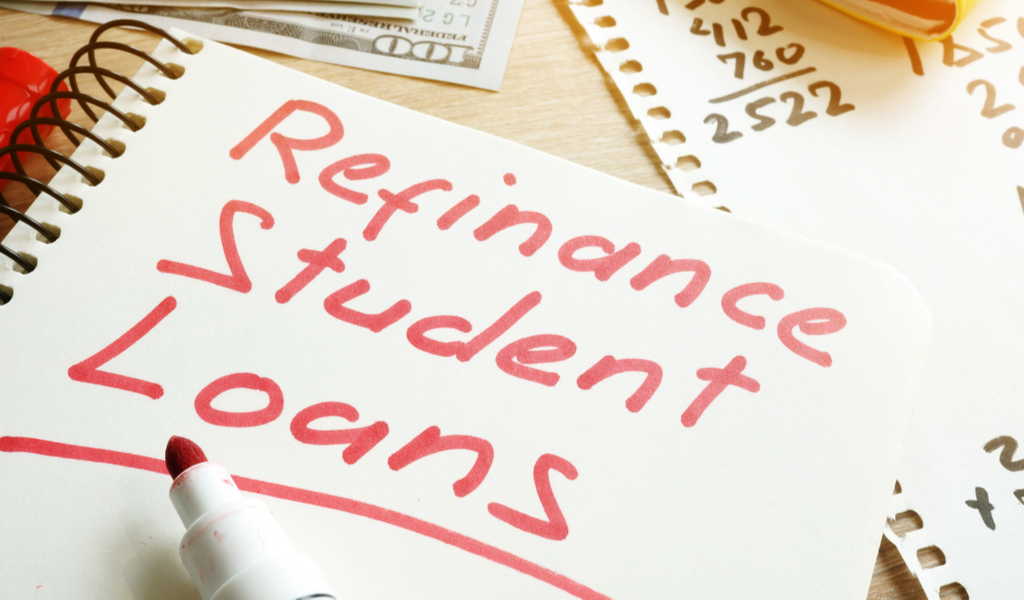Refinancing your loans is a solid strategy that can help you pay them off much more efficiently. In basic terms, you will be borrowing from one place to pay off all your individual loans. Therefore, refinancing your loans allows you to keep better track of your debts and helps you pay them back easily by providing better terms such as lower interest rates or a longer repayment period.
When it comes to student loan refinancing, you can combine your existing federal student loans, private student loans, or both, into a new, single student loan with lower interest rates. Depending on your objectives, this can either help you pay them back quicker or help you pay less overall.

Student loan refinancing may not be right for everyone, especially since it will make you ineligible for future government grants or pardons. However, if you’ve gone through your options and decided that it is the right choice for you, we’re here to help!
Here’s a 7-step guide to refinancing your student loans
Compare Different Loan Providers
The first step in getting your student loans refinanced is to go through your options and decide which provider you are going to pick. Different lenders will have different terms in regards to interest rates, payoff terms, minimum credit scores, and sometimes even residency requirements. Typically, most people pick the option with the lowest interest rates because it helps them save money, but that’s not the only thing to consider.
Gather Interest Rate Estimates
As mentioned, interest rates are one of the major selling points when it comes to picking a lender for student loan refinancing. The good news is that many loan providers allow you to check your new interest rate before you apply for no charge at all. The estimate will be drawn based on some basic information provided by you. It only takes a few minutes on the internet to find out if you pre-qualify for student loan refinancing. Plus, you can check your estimated interest rate from multiple lenders – this is called a soft credit check and does not cause any effect on your credit score.
Pick the Lender & Preferred Terms
Once you pick the provider that you want to go for, it’s time to finalize the terms of the refinanced loan. The main choice you will have to make will be whether to go for a fixed interest rate or a variable interest rate. With a fixed interest rate, you will be able to lock in the current rates for the entire duration of your repayment period. Variable rates, on the other hand, mean that your interest rate can change at any time.
The other main thing you have to decide is the loan repayment period. Generally, refinanced loans come with a time period of between 5 and 20 years. How quickly you wish to pay off your loans will influence your decision on interest rates as well. Variable interest rates are typically lower than fixed interest rates, but those who are planning to go for a longer repayment period prefer to get a fixed interest rate to avoid unpleasant surprises down the line. However, if you pick a shorter repayment period, variable interest rates might be the better choice as they will help you save a ton of money and you can be debt-free much faster as well!
Apply for the Loan
Applying for student loan refinancing is pretty simple to do nowadays, thanks to the internet. Most lenders have an online application process that won’t take you more than 15 minutes to do. Along with your application, you will also need to upload supporting documentation such as proof of citizenship or residency such as a government ID or social security number, valid ID such as a passport or driver’s license, and proof of income such as a job offer letter or pay stubs. Student loan statements from your current federal and private student loans will also need to be provided. You may also need to provide school transcripts or other proof of graduation.
You may also ask someone who has a stable financial standing to co-sign your loan. A co-signer with a strong credit and income profile can be advantageous in helping you get approved quicker and to get you a lower interest rate. The co-signer will also need to submit their documentation at the time of the application.

Credit Background Check
Once you’ve applied for your new loan, the lender will then do a hard credit pull to confirm your credit background. This is done to ensure that you will be able to repay your student loans in full while also fulfilling other financial duties such as debt and day-to-day living expenses. They will do this by analyzing your credit score, debt-to-income ratio, and other debt obligations.
At this stage, your lender will do a hard credit pull to confirm your credit background. Lenders may evaluate your credit score, other debt obligations, and your debt-to-income ratio. Your lender wants to ensure that you can repay your student loans in full and also pay your living expenses and any other debt.
You can also add a co-signer when you apply. If you’re applying with a co-signer, your co-signer will also submit their documentation. Co-signers who have a strong credit and income profile can help you get approved and could help you get a lower interest rate.
Sign Documents
If you are approved for student loan refinancing, it’s time to sign the final documents and disclosures. There is a three-day rescission period after you sign during which you can cancel the loan if you wish.
However, if you do not get approved, this does not mean you cannot apply to other student loan refinancing lenders. However, make sure to ask the lender to provide you with a reason why they rejected your application. This way, you can work towards rectifying or meeting these requirements before applying again. For instance, if your debt-to-income ratio isn’t adequate, you can try to increase your income or pay down other debt. You can improve your monthly cash flow by adding to your income, saving more money, and/or reducing expenses.
Loan Is Disbursed
Once you’ve completed all the steps and have signed on to your new lender, they will pay off all your existing student loans. Make sure to keep paying your previous lenders until you get written confirmation that those loans have been paid off. This way, you can avoid late charges if the new loan takes some time to be processed. Don’t worry about overpaying your old loan lenders; any extra amount you pay will be refunded.
Once you’ve confirmed that the new lender has paid off all your loans, you will then make monthly payments to them alone. You can set up automatic transfers from your bank account to ensure that you do not miss out on any payments. Plus, you may even get a discount of up to 0.25% from your lender for setting up autopay!



